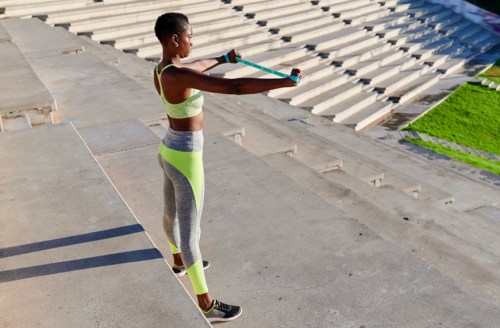Our editors independently select these products. Making a purchase through our links may earn Well+Good a commission
Resistance bands are useful tools for both beginners and advanced athletes. You can use resistance bands to gently build full-body strength. “Resistance bands are much easier on your body and offer a much safer, low-impact, and sustainable form of strength training, whereas weightlifting using free weights or machines can put unhealthy strain on your spine, joints, ligaments, and tendons,” says Dannah Eve, trainer and founder of the DE Method.
Experts in This Article
certified personal trainer and the founder of The DE Method
personal trainer
trainer and founder of MG Method
There are some important things to be aware of in order to get the most out of your resistance band leg workouts, upper body or core workouts. Below, DeBlair Tate, personal trainer and owner of 8Figured, dispels the top resistance band myths that get in the way of your workout routine.
Common myths about resistance bands
1. Myth: They’re not as effective as weights
If you’ve yet to use resistance bands because you don’t think they’ll be as effective as weights, it’s time to put that myth to rest. “The bands definitely increase muscle strength and the size similarly to free weights or machines,” says Tate.
2. Myth: It’s best to put the resistance band around your thighs
When working your lower body, you probably put the resistance band around your thighs. But Tate says the ankles are an option, too—it just depends on which muscles you want to focus on, and which exercises you do.
“The best determination of where to put the resistance band is primarily dependent on how you want to work the specific muscle group. You’ll get a good workout with the bands being on the ankles or the thighs,” she says. “For example, if you’re aiming to strengthen the glutes, quads, or hamstrings, place the band above your knees in a semi squat position. In the same sense, you can place the band around the ankles, standing with your feet hip-width apart and kicking back with the opposite leg, which gives you a good glute and hamstring workout as well.”
3. Myth: Light resistance bands won’t help you get stronger
All resistance bands—even the light ones!—will build up your strength. “It’s all about the repetition,” Tate says. “You can have a lighter band and increase the number of reps. That will give you an increase in strength.”
4. Myth: All resistance bands offer the same benefit
The resistance band you buy matters, so don’t just add any pack to your cart. “You want to make sure the bands are comfortable and sturdy. I’ve found that the rubber material bands aren’t as comfortable as the thicker premium fabric bands,” she says. “The rubber material bands also give faster and break more easily with too much resistance.” Try this pack of resistance bands ($19), which are made with soft cotton material and feature latex grips.
5. Myth: Your resistance band should be super tight
You want your resistance band to make you work. Just make sure it’s not too tight, which could lead to injury. “You want your bands tight enough to provide you with a challenge, but not too tight where it could cause you to pull a muscle,” says Tate. “As your strength increases, your band level can increase as well.”
Here’s a resistance band workout to try:
Oh hi! You look like someone who loves free workouts, discounts for cult-fave wellness brands, and exclusive Well+Good content. Sign up for Well+, our online community of wellness insiders, and unlock your rewards instantly.
Sign Up for Our Daily Newsletter
Get all the latest in wellness, trends, food, fitness, beauty, and more delivered right to your inbox.
Got it, you've been added to our email list.











